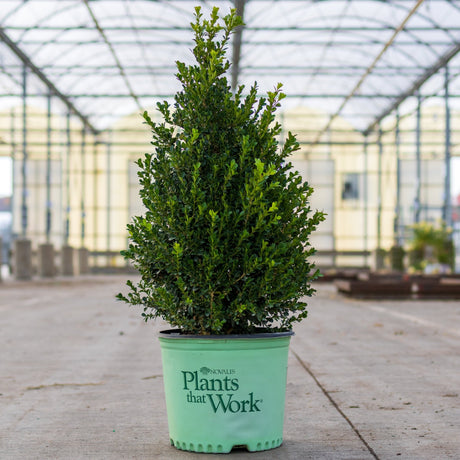All About Holly Hedges and Screens

Holly bushes are some of the best evergreen and deciduous plants for hedges! With glossy foliage, cheerful red berries, and a naturally dense growth habit, they create privacy, beauty, and structure in the landscape.
Great for both formal sheared hedges and informal screening, Holly provides lasting color and texture in every season. Their elegant leaves can be pointed, serrated, or oak-leaf shaped, adding visual interest, while bright fruit attracts birds in winter.
To get the most out of your Holly hedge, remember that pruning is key! Proper trimming maintains shape, encourages thick growth from top to bottom, and keeps your hedge healthy for decades.
- Why Choose Holly for Hedges?
- Planning and Planting a Holly Hedge
- Pruning and Care for Holly Hedges
- Best Holly Varieties for Hedges and Screening
- Holly Hedges That Keep Their Edge
Why Choose Holly For Hedges?
- Evergreen foliage for year-round privacy and color
- Cheerful red berries for seasonal interest and wildlife
- Perfect for formal or informal landscapes
- Varieties to suit small yards or large estates
- Durable, low-maintenance, and long-lived
- Many have thorny spines that make great defensive barriers that deter trespassers
Planning and Planting a Holly Hedge
Proper spacing is one of the most important steps in creating a hedge. Choose your Holly variety based on mature height and width, then decide how quickly you want a solid screen.
- Planted 3 feet apart: Forms a solid hedge in a few years
- Closer spacing: Faster privacy, but requires more plants
- Wider spacing: Uses fewer plants, but takes longer to fill in
As your hedge grows, allow the plants to touch so they form a dense green wall rather than remain individual shrubs. In the first few years, prune lightly to help roots establish and encourage new leaf growth.
Pruning Holly Hedges

Pruning is the secret to a full, healthy hedge. Holly responds well to trimming, but timing and technique matter:
- Keep the bottom wider than the top to prevent shading lower branches
- Prune in early summer (mid-July cut-off) so new growth hardens before winter
- Lightly trim in the first 1–2 years. Just snip stray tips
- Begin shaping once plants are established
- Rounded or dwarf types can be sheared into mounds or left natural
Head over to our Holly Care Blog for the complete guide to growing Holly bushes and trees!
Best Holly Varieties for Hedges and Screening

Nature Hills offers top-rated Holly plants for sale, each with unique habits and features:
- Nellie Stevens Holly: Large, vigorous grower with glossy leaves and berries
- Castle Spire Holly: Upright form, great for narrow hedges
- Castle Wall Holly: Dense and sturdy, excellent for tall screens
- Oakland Holly: Strong branching with oak-shaped leaves
- Oakleaf Holly: Classic oak-leaf foliage, bold backdrop plant
- Acadiana Holly: Robust, dark green leaves and strong form
- Sky Pencil Holly: Tall, narrow, architectural shape
- Sky Pointer Holly: Slim and upright, perfect for modern gardens
- Inkberry Holly: Smaller foliage, typically without spines
Columnar growers like Sky Pencil and Sky Pointer are ideal for small spaces or dramatic vertical accents. Larger selections, such as Nellie Stevens and Oakleaf Holly, shine as bold privacy hedges. Many can even be shaped into holiday-ready pyramids for festive outdoor décor.
Just remember, only female Holly plants produce berries, and only if there is a male pollinator nearby.
A Holly Hedge That Keeps Its Edge
From classic red-berried selections to tall and narrow architectural forms, Holly bushes provide year-round privacy, beauty, and structure. With proper planting and pruning, you'll enjoy hedges that are lush, full, and built to last. Keep the bottoms wide, snip with purpose, and let your Hollies shine as evergreen showstoppers.
Happy Planting!



























